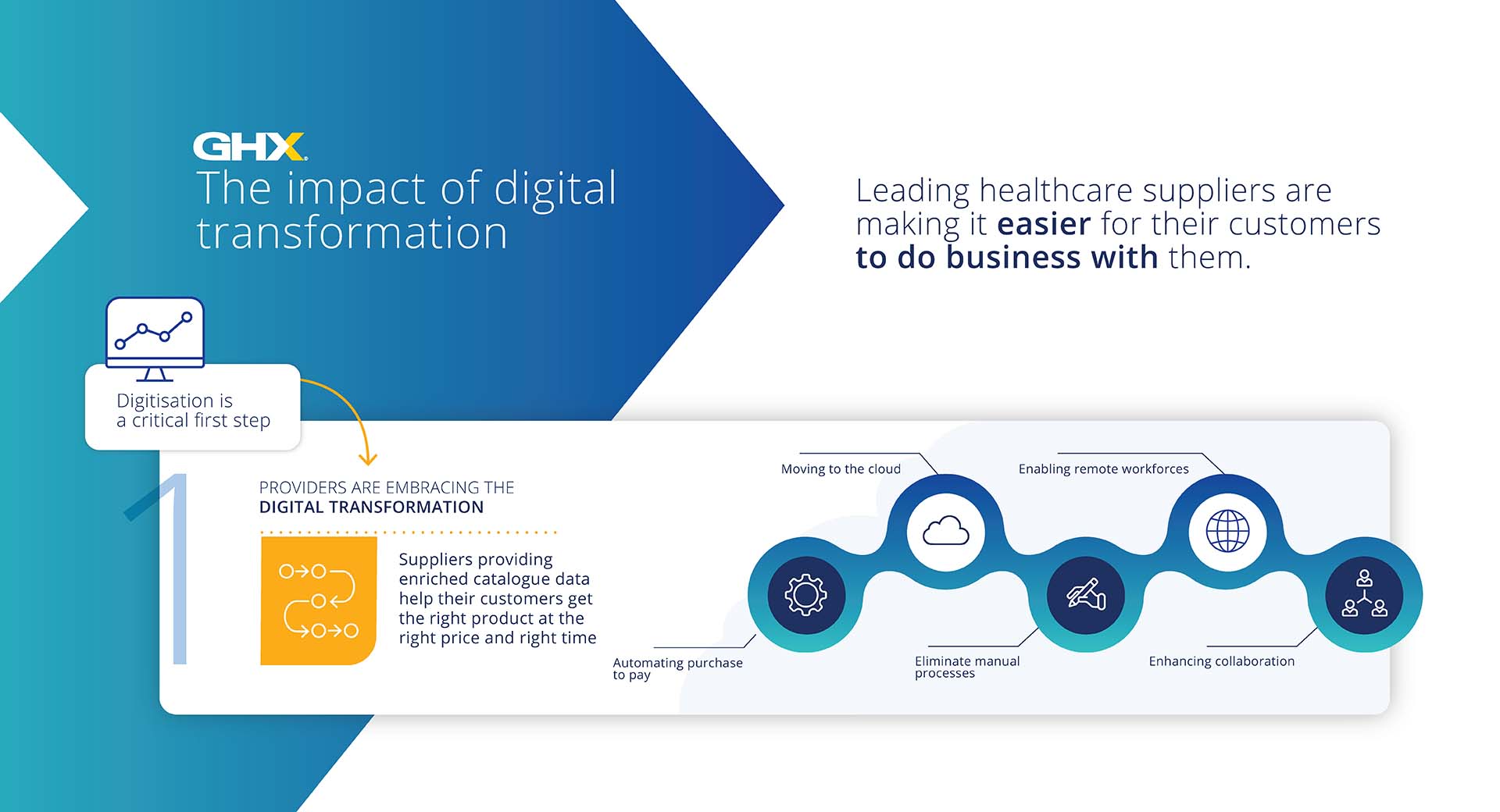Embracing a Digital Transformation Strategy
 Lower costs, optimised processes, stronger customer relationships: digital transformation is associated with many advantages for healthcare suppliers. However, to realise these benefits, more is needed than just introducing digital solutions. Suppliers must understand the entire customer experience and make their business processes as simple as possible.
Lower costs, optimised processes, stronger customer relationships: digital transformation is associated with many advantages for healthcare suppliers. However, to realise these benefits, more is needed than just introducing digital solutions. Suppliers must understand the entire customer experience and make their business processes as simple as possible.
- Simple Business Relationships for an Improved Customer Experience
- Digitalisation is a Critical First Step
- Automate Purchase-to-Pay Processes
- Enable Remote Working
- Improve Collaboration
- Transition to the Cloud
- Digital Transformation for an Improved Customer Experience
- Optimising the Digital Patient Experience thanks to the Digital Supply Chain
Simple Business Relationships for an Improved Customer Experience
Most would agree that being easy to do business with is a way to set your business apart and deepen customer relationships. It is undoubtedly so for suppliers in the competitive healthcare industry. Leading suppliers are looking at the complete customer experience and acting on the opportunity to support healthcare providers’ needs by embracing a digital transformation strategy.

Digitalisation is a Critical First Step
Digital transformation enables providers to deliver care, improve processes, and reduce costs. In addition, a digital enterprise can be much nimbler in addressing changing market dynamics.
But an organisation must digitally transform its entire operation to reach this state. There are two strategies currently helping providers make this move that also greatly benefit suppliers: automating the purchase-to-pay process and moving to a cloud-based ERP.

Automate Purchase-to-Pay Processes
Automating purchase-to-pay provides many benefits. It can reduce costs by eliminating manual processes, support a remote workforce, and create data points.
Suppliers who seek to support providers’ shift to a digital patient experience must deliver the same approach to their relationship with their provider customers. Slow, error-prone manual processes are an obstacle to this approach.
As an example, customers need to understand order fulfilment and supply delivery. The expectation is that acknowledgement will no longer occur in hours or days, but in minutes. Manual processes simply cannot meet this demand.

Enable Remote Working
The pandemic changed work habits forever. To retain the best talent, remote workforce support has become a reality for suppliers and providers. Automation tools support this as they can be leveraged from anywhere and free up scarce staff to do things only humans can do.
For example, accounts payable staff may no longer be in a location to receive and process paper-based invoicing. Suppliers establishing a digital customer experience must realise this and move to e-Invoicing and payments. This move also allows providers and suppliers to take advantage of early payment opportunities and maximise working capital.

Improve Collaboration
Finally, an agile enterprise that responds to rapid change must make data-driven decisions. Each automated supply chain transaction generates a data point that can support decisions across the entire supply chain when aggregated.

Transition to the Cloud
New care models and locations are driving the second digital transformation strategy, moving to a cloud-based ERP. This technology infrastructure fosters collaboration between providers and suppliers. As information silos are dismantled and processes are extended closer to the point of care, outdated and erroneous information can generate negative impacts throughout the supply chain.
These impacts are a leading cause of disruption in the acquisition and procurement of supplies, which strains relationships with providers and can also impact patient care. Providers are leveraging these expanded technological capabilities to drive business process change and avoid these impacts.
Digital Transformation for an Improved Customer Experience
As suppliers think about delivering a digital experience, they must understand their role in their customers’ digital transformation journey. They must lean in to support greater automation, but a digital experience requires automation and data.
Suppliers must consider what data and information exists in their organisation that can improve customers’ experience. Suppliers further down the journey of delivering a digital experience are providing catalogue data with rich attributes like images and real-time contract information to help ensure their customers are getting the right product at the right price at the right time.
Optimising the Digital Patient Experience thanks to the Digital Supply Chain
Catalogue and contract data aligned between provider and supplier ERP systems coupled with automated purchase-to-pay creates a foundation that gives suppliers greater visibility across the healthcare supply chain and into their customers.
This results in more strategic and value-based financial decisions that also help improve a supplier’s operational performance. For example, it allows suppliers to reallocate product to areas with the highest demand.
That foundation allows the relationship to extend further to clinical systems and the point of care. A digital experience from suppliers that reaches the patient at the point of care is the ideal state. It is here where the digital patient experience and the digital supply chain meet.
[Originally published on May 02, 2022 in Medical Product Outsourcing Magazine]
In the second part of our special on digital transformation, learn how healthcare suppliers can use the mountains of data to better support decisions for themselves and their customers.